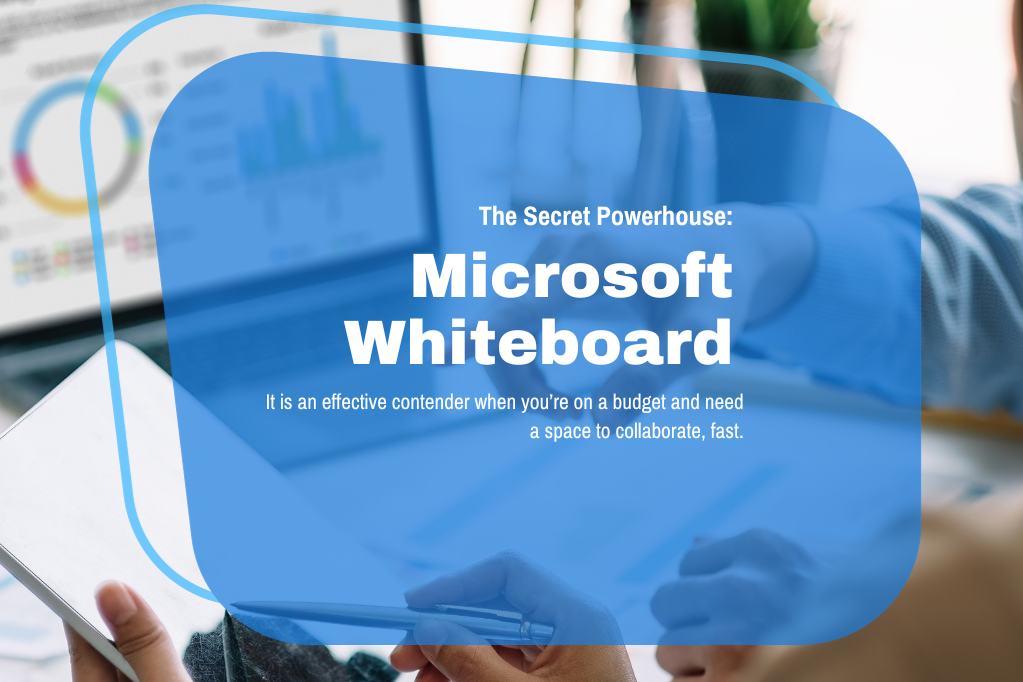When I started at PlayStation back in January of 2022, it was quite the adjustment. Unlike many of my peers, it was my first job move after graduating from college. I didn’t know what I was getting into. What I did know was that the most important step was to listen and observe. Beyond that, I was given the freedom to foster a community of relentless improvement and cultivate an environment where my teams could thrive.
With those two prime directives, I set forth and summoned an unlikely hero to help my team, the Goats of Tsushima, survive the forways of game development. Who might this unlikely hero be? Meet Microsoft Whiteboard.
In this blog post, we’re continuing our tools and template series and introducing a collaboration tool that may already be part of your arsenal.
The secret powerhouse
If your company leverages Microsoft 365, then you probably didn’t know that you also get Microsoft Whiteboard. As a result, you don’t need any license agreements or subscriptions to get started. Anyone can create a whiteboard, and you can share it with anyone within your company as long as they also have a Microsoft 365 account, too. Plus, Microsoft offers a Getting Started Guide to jumpstart your usage.
Microsoft Whiteboard operates similarly to other tools in the market. Once you create a board, you are able to leverage existing templates ranging from brainstorming to ice breakers to strategy and planning and beyond. If you are feeling creative and/or cannot find one that fits your needs, you can build your own template that you can share with your colleagues. From there, you and your teams can use an array of tools, which include sticky notes, text boxes, and emojis, to share ideas and align on outcomes. In addition, there is a timer feature that helps you keep your discussions on track.
When all is said and done, the nice part is that Whiteboard integrates with Microsoft’s Active Directory (AD) so that you can quickly manage the permissions to your various whiteboards. For example, if you already had a distribution list that you used in Microsoft Outlook, such as “goats-teammembers@inbitesize.com,” then, when using the share option, you can simply add that email instead of adding all the individual group members to the board.
Where it wins is its integration with Microsoft Teams. As long as you have three participants, you can open the Whiteboard app to quickly get folks brainstorming in a virtual and/or hybrid environment. The whiteboard will remain as a tab when navigating to the meeting within Microsoft Teams so that you and your teams can quickly reference the right board and continue adding any details asynchronously. Beyond that, you can share the board with teammates who may not have been invited to the meeting.
Growing pains
Just like its competitors, Microsoft Whiteboard has its own limitations. Unfortunately, you are not able to organize your boards into projects and/or folders. Therefore, you’ll have to share your boards with the appropriate groups each time. As a workaround, I have set up a naming convention so that I can quickly find the boards I need to reference.
In addition, you have a limited selection of widgets. One of the key aspects of other tools in the market is that you can organize various objects into frames that you can hide and group, which helps with board formatting. Since you cannot organize your board into sections, there may be a limit to your participants’ focus and attention if you happen to be covering a lot of topics within your workshop. For me, I use blocks and other sticky notes to temporarily hide sections that I may not be ready to tackle.
Furthermore, if you happen to be working with external partners who may not be part of your Microsoft tenant, they will lose access to the Whiteboard once they leave the Microsoft Teams meeting. I leverage screenshots and post-meeting summaries to help keep everyone on track. (Note that they will be able to contribute as long as they were invited to the Teams meeting and your administrator has allowed access to external folks.)
Despite these limitations, Microsoft is committed to continuously evolve the tool. Be sure to check out their webpage for the latest changes.
Listen and observe
Now you may ask how did Whiteboard become an unlikely hero for us Goats? When I first joined the Goats, they had strong agile practices and knew the importance of reflecting and taking action sprint after sprint. As a result, they were actively using Google Jamboards to run their retrospectives. The good thing about the Goats was that they were a very vocal and engaged team. This meant that we quickly ran out of real estate and had to use many slides to collect all our ideas.
Hence, I introduced Microsoft Whiteboard. It was easy to transition since the tool had a similar user experience as Jamboard. Since then, we have had an endless amount of space where everyone has had a chance to share their ideas and vote on a path forward.
Beyond retrospectives, we have also used Microsoft Whiteboard to break down features and their associated use cases into bite-size chunks. To do this, we would leverage the tool to diagram customers’ journeys and sort & collect assumptions and questions that we had to validate with our stakeholders.
In conclusion
Microsoft Whiteboard is an effective contender when you’re on a budget and need a space to collaborate, fast. With its collection of templates and built-in Microsoft Teams integration, this tool can stand in for any whiteboard session and potentially pave the way for future tools like, Miro and Mural. So, get a leg up from your peers and show them this world of virtual collaboration that you can set up anytime and anywhere. How has Microsoft Whiteboard saved the day for you?
Drop us a line and let us know what tools you’re curious about.
